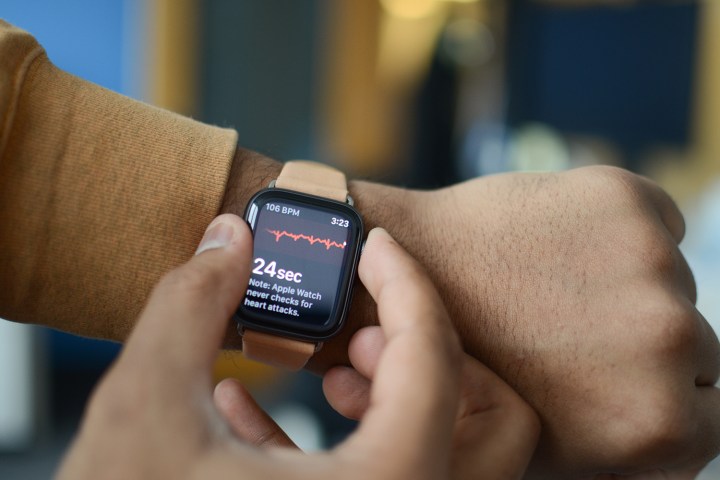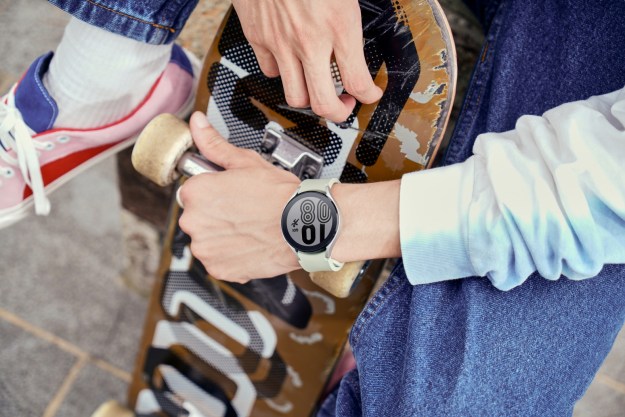
If you’re relaxing on the couch and suddenly feel dizzy, and it seems like your heart is pounding out of your chest, you might not head to the emergency room ASAP. But if your Apple Watch was also telling you to seek medical attention, you might change your mind. The watch has been credited with saving a few lives, but some health professionals worry there are drawbacks to fitness trackers that manufacturers aren’t addressing.
After announcing the Apple Watch Series 4’s electrocardiogram (ECG) functionality in September 2018, Apple made the feature available in December. Some doctors were dismayed the Food and Drug Administration cleared the Apple Watch’s EKG software without releasing the data it looked at or or subjecting it to peer review.
To use the ECG function, the user touches the wheel on the side of the watch (known as the Digital Crown) for 30 seconds. The electrodes on the back of the watch and in the button create what’s called a lead when in contact with both your wrist and finger, generating an ECG waveform. Though Apple says it’s not a diagnostic tool, the idea is for it to detect irregular heart rhythms and atrial fibrillation. Both could signal serious health problems.
“The main worry is making a generation of hypochondriacs.”
“It’s probably not a good idea for a hypochondriac, but the potential advantages far outweigh any potential downside,” one physician told Digital Trends in 2018. Others aren’t so sure.
For one thing, the Apple Watch uses fewer leads than an ECG you’d get in your doctor’s office; they might also put a sticker on your chest, for example. The more leads you have, the more ways you have of looking at your heart. A single lead only offers one view.
“Think of ships on the horizon,” cardiologist Rohin Francis told Digital Trends. “You can see them go left and right, but you won’t be able to tell if they’re coming towards or [going] away from you.” Additionally, with three or more electrodes, any abnormal signal in one lead could be dismissed as interference if it didn’t show up in the others.
With the Watch’s single lead, Francis is worried about false positives. Atrial fibrillation isn’t very common in younger people — the same people likely to buy the Apple Watch.

“It is statistically much less likely that a positive result flagged up by the Watch will be true atrial fibrillation in a 35-year-old, compared to a 75-year-old,” he said. “In other words, the inaccuracy of the watch is acceptable in a population with a high rate of the disease, because you are expecting to find a lot of AF. But in a young population, that same degree of inaccuracy becomes a problem.”
A false positive could send a healthy 35-year-old down a rabbit hole of expensive, unnecessary tests.
“The main worry is making a generation of hypochondriacs,” Francis said, and it’s something he’s noticing with heart rate trackers. Variations in heart rate are normal and well-understood, so doctors can easily reassure patients who are now noticing the changes.
“I am a pediatric emergency medicine doctor, so I see a lot of misadventures with these monitors.”
“If we start seeing little bursts of AF, we don’t know if that’s normal or something to be worried about, so I can’t give a patient that instant reassurance,” Francis said. “I don’t think it’s healthy for people to be overly worried about their vitals all the time.” One function he’d prefer to see in a fitness tracker, though, is a blood pressure monitor.
“I think undiagnosed high blood pressure is a much bigger problem and a much bigger killer than undiagnosed AF,” he said.
Apple Watch’s ECG is brand new, so whether it will lead to misdiagnosis of atrial fibrillation is still unknown. But wearable baby monitors have been around for some time and are causing all kinds of headaches for pediatricians. Though they’re not FDA-approved, they claim to track babies’ heart rates and blood oxygen levels. They can lead to overdiagnosis, as well.
“There is no evidence that consumer infant physiologic monitors are life-saving, and there is potential harm if parents choose to use them,” according to authors of a study published in the Journal of the American Medical Association.

“I am a pediatric emergency medicine doctor, so I see a lot of misadventures with these monitors,” wrote Dr. Elizabeth Murray, a pediatrician with University of Rochester Medicine’s Golisano Children’s Hospital. “I also see a very large number of infant deaths from unsafe sleep, so this topic is very close to my heart.”
She said the only well-studied methods of reducing sudden infant death syndrome (SIDS) don’t involve monitors at all but include the American Academy of Pediatrics’ recommendations for safe sleeping.
“I can easily say that I have cared for far more children that have had accidental alarms from these devices than those who are truly ill,” Murray said. “In fact, I cannot recall a time when we have actually found a true problem.”
Murray also doesn’t recommend fitness trackers for older kids.
“I cannot recall a time when we have actually found a true problem.”
“We never want children to feel that they have to hit a certain number of steps or a specific distance each day,” she said. “School-aged children are tracked a lot — homework, how good are they at sports, did they make the concert band, etc.”
Instead, she thinks encouraging kids to just play is a better way to keep them active.
Fitness trackers’ focus on numbers is what worries Claire Mysko, CEO of the National Eating Disorders Association.
“A lot of what’s going on with someone who’s either at risk or actively struggling with an eating disorder can be amplified through the use of these devices,” she said.

Though it had a very small sample size of eight women, a recent study found that using a fitness tracker could lead to an over-reliance on the devices and feelings of self-loathing.
Apple is partnering with Recovery Record, an eating disorder treatment app, for a study with the Apple Watch aimed at predicting and preventing binge-eating episodes. That collaboration is encouraging for Mysko, who would like to see more partnerships with device manufacturers in the future. Trackers could alert behaviors, suggesting wearers may be at risk of developing an eating disorder, for example.
“There’s a big population of people who are using these devices who would benefit from some kind of screening,” she said. “Given the risk factor of population, that would be the responsible thing for them to do.”
For every wearable from a big-name company like Apple, there are dozens from newer brands that promise to track ovulation cycles or count your calories as you consume them. As tempting as these devices might be to strap on, there isn’t always clear evidence to back up these claims.
“It’s 100 percent buyer beware right now.”
“Most of the features included in consumer-grade wearable devices are based on sound science,” said Dr. Jonathan Peake, a lecturer at Queensland University of Technology, in an email. “However, I do believe that companies could engage more with independent researchers to validate their products – that is provide evidence from published, peer-reviewed journals that their products match up, to a reasonable degree, with gold standard methods for measuring such biometrics.”
It may not seem like a big deal if your fitness tracker says you walked 6,500 steps when you really walked 7,000, but it can make a difference for some people with conditions such as knee osteoarthritis, said Dr. Reed Ferber, director of the University of Calgary’s running injury clinic. He’s also leading the school’s Wearable Technology Research and Collaboration training program.
“I’ve never seen a study that’s validated anything against a gold-standard, university sleep lab,” he said.
That could be problematic if an airline company requires its pilots to prove they’ve gotten enough sleep before a flight, and their devices are over- or underestimating the house.
“These are just algorithms that people are developing in the company’s own laboratory without any validation,” he said.
Sometimes it can be difficult to determine what phrases such as “clinically proven” means. Right now, the onus is on potential customers to dig into the company’s claims.
“If consumers are concerned about getting value for money and using wearables that do what the manufacturers claim, then they should be looking for evidence of published, peer-reviewed research in academic journals,” Peake said.
Eventually, Ferber expects insurance companies will start demanding more of this kind of research from manufacturers as wearables become more tied to health.
“It’s exciting to see how wearables are being so fully integrated into our activities of daily living,” he said. “I just think at this point, it is the Wild Wild West in terms of what these devices are claiming, what they’re measuring. It’s 100 percent buyer beware right now.”


